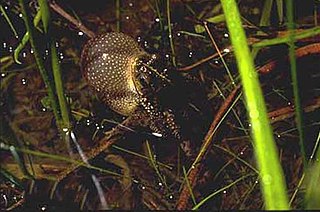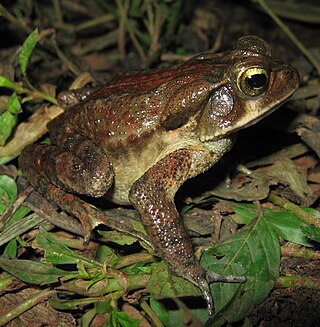Rhinella rostrata, also known as the Mesopotamia beaked toad, is a species of toad endemic to Colombia. It is only known from its type locality near the village of Mesopotamia, on the western slope of the Cordillera Occidental in the south of the Antioquia Department.

Rhinella achalensis is a species of toad in the family Bufonidae that is endemic to northern Argentina.
Rhinella acutirostris is a species of toad in the family Bufonidae. It is found in Brazil, Colombia, Panama, and Venezuela. Its natural habitats are subtropical or tropical moist lowland forests, freshwater marshes, and intermittent freshwater marshes.

Rhinella atacamensis, sometimes called the Vallenar toad or Atacama toad, is a species of toad in the family Bufonidae. It is endemic to Chile and occurs between Paposo and Las Chilcas. It inhabits the desert Pacific coastal region with Mediterranean influences and is found in and near oases and streams. Breeding takes place in permanent pools, streams, and rivers. While abundant at a few sites, it has declined overall and gone locally extinct at some sites. Threats to this species include extensive droughts and water pollution as well as extraction of surface water, mining, agriculture, livestock farming, and timber plantations.
Rhinella humboldti is a species of toad in the family Bufonidae. It is found in Colombia, Venezuela, Trinidad, and the Guianas. This species was originally considered to be a subspecies of Rhinella granulosa.
Rhinella castaneotica is a species of toad in the family Bufonidae. It is known from the Amazon Basin in Bolivia (Pando), Brazil, Colombia, and eastern Peru, but likely occurs wider in the upper Amazon Basin. Its natural habitats are tropical moist old-growth lowland forests. It is a forest floor species that breeds in Brazil nut capsules and temporary pools. There are no known significant threats to this species.

Rhinella dorbignyi is a South American species of toad in the family Bufonidae. The specific name, dorbignyi, is in honor of French naturalist Alcide d'Orbigny. Its common name is d'Orbigny's toad or Dorbigny's toad [sic].

The South American common toad is a species complex of toads in the family Bufonidae. They are found throughout the Amazonian South America and eastern Panama. It was originally believed to be a single species, but is now known to represent a complex of more than one.

Rhinella pombali is a hybrid species of toad from south-eastern Brazil, named after José Perez Pombal Jr., a Brazilian herpetologist. It was originally described in 2004 as a distinct species, but a genetic study published in 2012 found it to be a hybrid of Rhinella ornata and Rhinella crucifer; it is also morphologically intermediate between these species. It is therefore no longer considered a valid species, although it is still present in some listings.
Rhinella rubropunctata is a species of toad in the family Bufonidae that is found in southern Chile and Argentina. Its natural habitats are humid to xeric temperate forests and open environments. It tolerates a certain degree of disturbance. Breeding takes place in shallow temporary ponds near rivers, reservoirs and lakes. It is threatened by habitat degradation and fragmentation.
Rhinella acrolopha, also known as Cerro Mali beaked toad, is a species of toad in the family Bufonidae. It is found in the Serranía del Darién in eastern Panama and in the immediately adjacent northwestern Colombia, in the Los Katíos National Park. The specific name acrolopha is derived from the Greek akrolophos, meaning crest of a mountain or ridge, and refers to the isolated occurrence of this species at high elevations in the Serranía del Darién. However, the International Union for Conservation of Nature (IUCN) characterizes it as a lowland species.
Rhinella lindae is a species of toad in the family Bufonidae. It is endemic to Colombia and known from its type locality, Murri in the municipality of Frontino, and from Las Orquídeas National Natural Park, both on the western slope of the Cordillera Occidental, Antioquia Department. The specific name lindae honors Linda Trueb, an American herpetologist. However, common name Murri beaked toad has been coined for this species.

Rhinella macrorhina is a species of toad in the family Bufonidae. It is endemic to Colombia. Its natural habitat is subtropical or tropical moist montane forests. It is threatened by habitat loss.
Rhinella nicefori is a species of toad in the family Bufonidae. It is endemic to Colombia. Its natural habitat is subtropical or tropical high-altitude grassland. It is threatened by habitat loss.
Rhinella ruizi is a species of toad in the family Bufonidae. It is endemic to the Cordillera Central in Antioquia, Colombia. The specific name ruizi honors Pedro Miguel Ruiz-Carranza, a Colombian herpetologist.
Rhinella tenrec is a species of toad in the family Bufonidae. It is endemic to Colombia. Its natural habitat is subtropical or tropical moist lowland forests. It is threatened by habitat loss.
Rhinella truebae is a species of toad in the family Bufonidae. It is endemic to Colombia.
Nymphargus cristinae is a species of frog in the family Centrolenidae, formerly placed in Cochranella. It is endemic to Colombia where it is only known near its type locality on the western slope of the Cordillera Occidental in Urrao, Antioquia. Its natural habitat is sub-Andean primary forest. It occurs on vegetation next to streams with canopy cover over the stream. Its conservation status is unclear but habitat degradation and loss caused by cattle raising, timber extraction, and cultivation of illegal crops are major threats.
Serranobatrachus cristinae is a species of frog in the family Strabomantidae. It is endemic to Colombia. Its natural habitats are tropical moist montane forests and rivers. It is threatened by habitat loss.

María Cristina Ardila-Robayo was a Colombian herpetologist. She was professor at the National University of Colombia, Bogotá, and worked closely with the Natural History Museum of the university. In 2010 she was credited as having described 28 new species of amphibians from Colombia; as of late 2018, the Amphibian Species of the World lists 31 valid species described by her. She also worked with caimans and crocodiles and lead biodiversity restoration projects.







